Piezoelectric Materials Market Research, 2031
The global piezoelectric materials market was valued at $1.4 billion in 2021, and is projected to reach $2.5 billion by 2031, growing at a CAGR of 6.2% from 2022 to 2031.
Piezoelectric materials are materials such as quartz, barium titanate, lithium niobate, and others that have the potential to convert mechanical effects into electrical signals or vice versa. Piezoelectric materials are used to power a wide range of devices such as knitting and braille machinery, video cameras, smartphones, and others. Furthermore, these are used in producing various components such as actuators, motors, sensors, acoustic devices, and others.
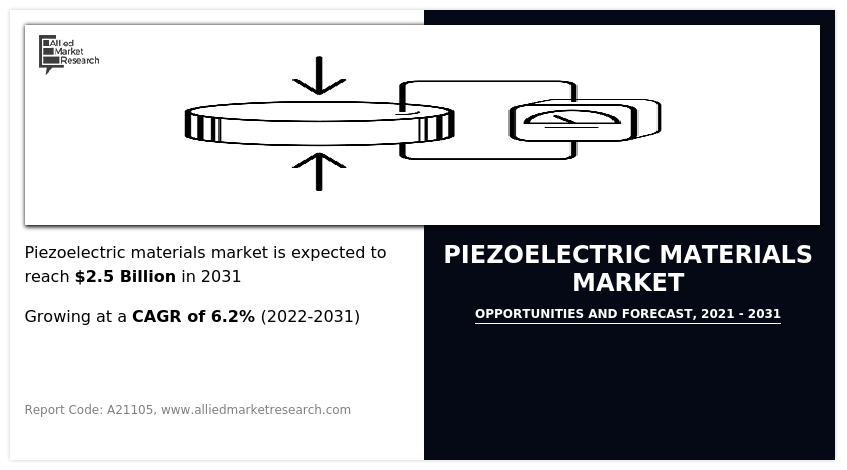
The growth of the global piezoelectric materials market is driven by an increase in demand for a wide range of consumer goods wherein piezoelectric materials are widely used in powering flame igniters, buzzers, electric toothbrushes, humidifiers, sensors, and others. Furthermore, these are used by medical professionals in their medical devices to monitor and perform surgical procedures. Also, these are used in ultrasound, pulse measurement, stethoscopes, monitoring sleep studies, and other medical-related applications. These factors together may act as the key drivers responsible for the growth of the piezoelectric materials market.
However, piezoelectric materials are unable to differentiate between noise and vibrations and hence, produce the same signals that lead to their ineffectiveness. This factor is responsible for producing wrong results during monitoring activities. Moreover, piezoelectric materials when subjected to harsh environments such as heavy stress and high temperature, the consistency of results produced by the piezoelectric materials get affected. These factors may reduce the potential application of piezoelectric materials in highly precise equipment in various end-use sectors; thus, hampering the market growth.
On the contrary, governments of both developed and developing economies such as the U.S., China, India, and others are constantly engaged in increasing their spending to develop high-technology aircraft and fighter jets with modern armor facilities where piezoelectric materials are used as piezoelectric energy harvests used for generating power level from nanowatts to microwatts. Furthermore, piezoelectric materials are used in transducers, actuators, motors, generators, and other major electrical components of aircraft and fighter jets for monitoring and energy conversion purposes. According to a report published by India Brand Equity Foundation in January 2021, the aerospace sector in India is growing day by day and is projected to reach US$ 70 billion by 2030. This is anticipated to increase the demand for piezoelectric materials in the growing aerospace sector; thus, creating remunerative opportunities for the market.
The piezoelectric materials market is segmented into application, material type and end-use, and region. By material type, the market is divided into composite, ceramic, and polymeric. By application, the market is classified into actuators, sensors, motors, acoustic devices, SONAR, and others. By end use, it is fragmented into automotive, information technology, healthcare, consumer goods, and others. Region-wise, the market is studied across North America, Europe, Asia-Pacific, and LAMEA.
The leading players operating in the global piezoelectric materials market include Arkema S.A., CeramTec GmbH, Johnson Matthey, PI Ceramic GmbH, Piezo Kinetics, Inc, Piezomechanik Dr. Lutz Pickelmann GmbH, Solvay, Sparkler Ceramics Pvt. Ltd., TDK Electronics AG, and TRS Technologies, Inc. The global piezoelectric materials market report provides an in-depth competitive analysis as well as profiles of these major players.
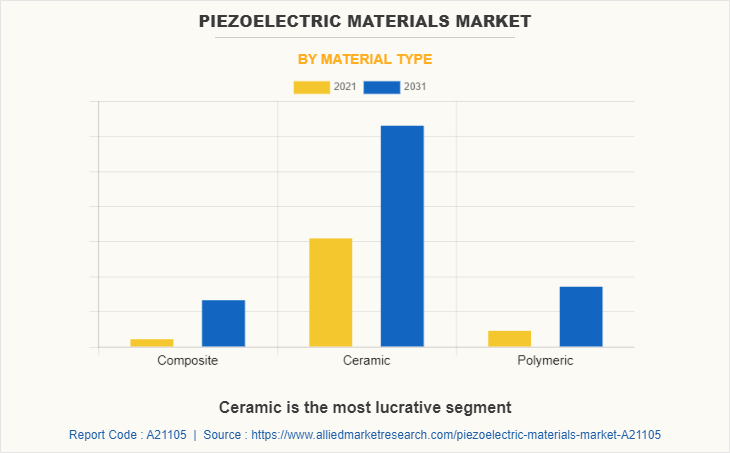
By material type, the ceramic segment was the largest revenue generator and is anticipated to grow at a CAGR of 6.0% during the forecast period. The utilization of piezoelectric ceramics in applications such as watches, ultrasonic power transducers, ultrasonic welding, and others is the major key market trend in the global market. In addition, the rise in demand for consumer goods which in turn has led the industrial manufacturing sector to witness significant growth where piezoelectric ceramics are used to for producing detection devices, ultrasonic devices, and other industrial devices. This may act as one of the key drivers responsible for the growth of piezoelectric materials for ceramic types.
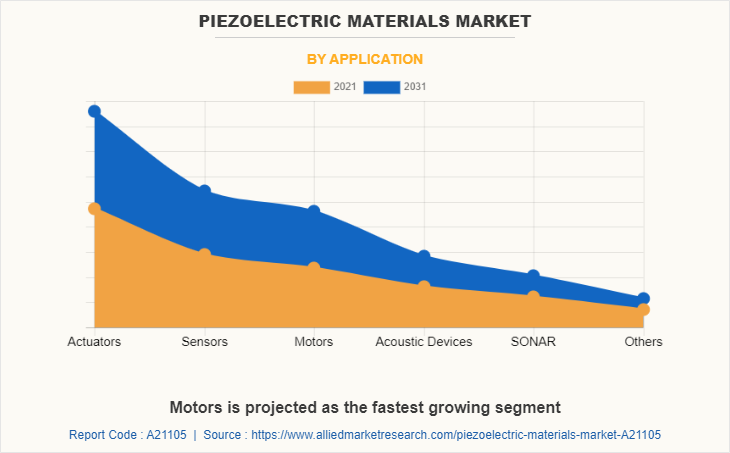
By application, the actuators segment dominated the global market in 2021, and is anticipated to grow at a CAGR of 6.2% during the forecast period. The increase in trend for industrial automation has surged the demand for piezoelectric materials-based actuators that are used for producing motion by converting energy and signals going through the system. This may act as one of the key drivers responsible for the growth of the piezoelectric market for actuators application. In addition, the rise in use of actuators among heavy machinery in automotive and manufacturing sectors make further boost the growth of the piezoelectric materials market during the forecast period.
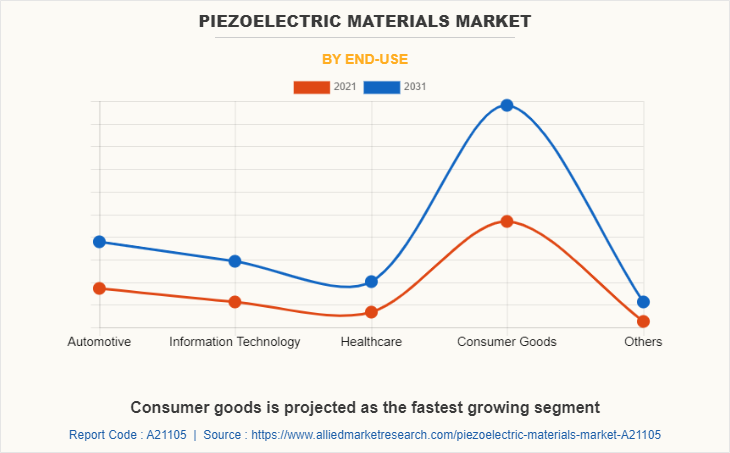
By end-use, the consumer goods segment dominated the global market in 2021, and is anticipated to grow at a CAGR of 6.6% during the forecast period. Factors such as a rise in disposable income coupled with an increase in demand for consumer goods which in turn has led the piezoelectric materials market to witness significant growth owing to the fact that piezoelectric materials are used for monitoring changes in various parameters such as temperatures, pressure, and others and then converting them into electrical signals. This may act as one of the key drivers responsible for the growth of the piezoelectric materials market in the growing consumer goods sector.
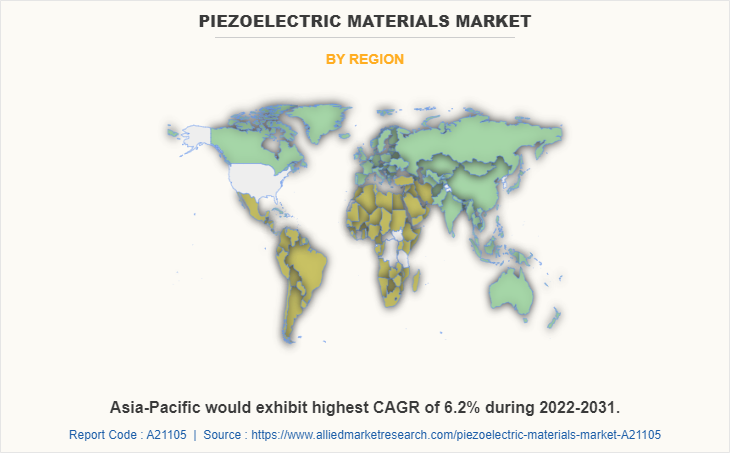
The Asia-Pacific piezoelectric materials market size is projected to grow at the highest CAGR during the forecast period. The rise in automotive, healthcare, and other sectors has enhanced the performance of the piezoelectric materials market in the Asia-Pacific region. China's industrial sector is increasing rapidly which in turn has enhanced the performance of the piezoelectric materials used for producing a wide range of industrial devices such as motion sensors, generators, motors, and others. According to a report published by the United Nations Statistics Division, China witnessed around 28.7% of the global manufacturing output for consumer goods in 2019. Also, countries such as India and Australia are witnessing a rapid increase in automotive sectors where piezoelectric materials are employed in actuators, fuel injectors, sensors, and various safety systems of vehicles. For instance, according to a report published by the Indian Ministry of Commerce and Industry, the automotive sector in India is expected to grow at a compound annual rate (CAGR) of 5.9%. This may enhance the performance of the piezoelectric materials market in the Asia-Pacific region.
Report key highlighters
- The value of the piezoelectric materials market is analyzed in millions.
- The piezoelectric materials market is consolidated in nature with few players such as Arkema S.A., CeramTec GmbH, and Johnson Matthey which hold a significant share of the market.
- Countries such as China, the U.S., Japan, Germany, and Brazil hold a significant share of the global piezoelectric materials market.
- Factors such as escalating demand for piezoelectric materials from healthcare, automotive, and other sectors are the major drivers for the market during the forecast period.
IMPACT OF COVID-19 ON THE GLOBAL PIEZOELECTRIC MATERIALS MARKET
The piezoelectric materials market has been negatively impacted due to the wake of the COVID-19 pandemic, owing to its dependence on automotive, building & construction, consumer goods, and other end-use sectors. The increasing risk of infection among the workforce has resulted in delayed construction projects amid the COVID-19 scenario. For instance, according to an article published by CNA in May 2021, the construction Industry Joint Committee (CIJC) has said that the shortage of manpower may lead to delays in construction projects attributed to workplace safety, and other factors.
Key Benefits For Stakeholders
- This report provides a quantitative analysis of the market segments, current trends, estimations, and dynamics of the piezoelectric materials market analysis from 2021 to 2031 to identify the prevailing piezoelectric materials market opportunities.
- Market research is offered along with information related to key drivers, restraints, and opportunities.
- Porter's five forces analysis highlights the potency of buyers and suppliers to enable stakeholders to make profit-oriented business decisions and strengthen their supplier-buyer network.
- In-depth analysis of the piezoelectric materials market segmentation assists to determine the prevailing market opportunities.
- Major countries in each region are mapped according to their revenue contribution to the global market.
- Market player positioning facilitates benchmarking and provides a clear understanding of the present position of the market players.
- The report includes an analysis of the regional as well as global piezoelectric materials market trends, key players, market segments, application areas, and market growth strategies.
Piezoelectric Materials Market Report Highlights
| Aspects | Details |
| Market Size By 2031 | USD 2.5 billion |
| Growth Rate | CAGR of 6.2% |
| Forecast period | 2021 - 2031 |
| Report Pages | 252 |
| By Application |
|
| By Material Type |
|
| By End-use |
|
| By Region |
|
| Key Market Players | TDK Electronics AG, Arkema S.A., CeramTec GmbH, TRS Technologies, Inc., solvay, PI Ceramic GmbH, Johnson Matthey plc, Piezo Kinetics Inc., Sparkler Ceramics Pvt. Ltd., Piezomechanik Dr. Lutz Pickelmann GmbH |
Analyst Review
According to the CXOs of major companies, the global piezoelectric materials market is expected to exhibit high growth potential during the forecast period. Piezoelectric materials are used in a variety of end-use sectors, such as automotive, consumer goods manufacturing, information & technology, and others for producing actuators, sensors, motors, and others. The growing adoption of luxury cars & sports utility vehicles (SUVs) for outdoor recreational activities leads to the need for effective piezoelectric materials solvents used for the mechanical movement of adjusting mirrors, lenses, sunroofs, and other automotive parts may fuel the demand for the piezoelectric materials market.
In addition, piezoelectric materials possess excellent significant properties, such as high strain constants, permittivity, high coupling constants, and high charge output that make them best-suited for use in the healthcare sector for monitoring dynamic heartbeat or breathing patterns in equipment such as stethoscope, pulse measurement devices, electrocardiography, and others. Ceramic piezoelectric materials have the potential to convert mechanical effects into an electrical signal or vice versa that widens their application among in watches, motion sensors, high frequency loudspeakers, and other devices. Furthermore, factors such as high onset action and efficiency has surged the popularity of piezoelectric materials in the information technology sector. CXOs further added that sustained economic growth and development of the consumer goods sector have increased the popularity of piezoelectric materials.
There is a current trend in the industrial automation sector where the demand for piezoelectric materials-based actuators is rising, which are used for producing motion by converting energy and signals going through the system.
The actuators segment dominated the global market in 2021, and is anticipated to grow at a CAGR of 6.2% during the forecast period.
The Asia-Pacific is the largest market in the global piezoelectric materials market in 2021.
The global piezoelectric materials market is projected to reach $2.46 billion by 2031, growing at a CAGR of 6.2% from 2022 to 2031.
The leading players operating in the global piezoelectric materials market include, Arkema S.A., CeramTec GmbH, Johnson Matthey, PI Ceramic GmbH, Piezo Kinetics, Inc, Piezomechanik Dr. Lutz Pickelmann GmbH, Solvay, Sparkler Ceramics Pvt. Ltd., TDK Electronics AG, and TRS Technologies, Inc.
Loading Table Of Content...


